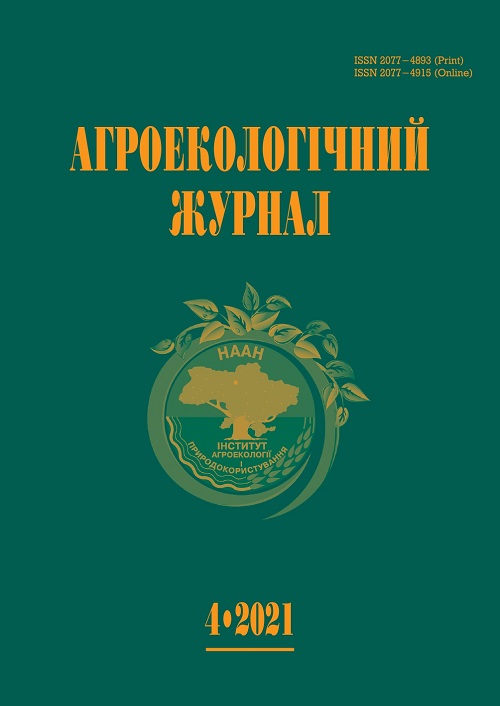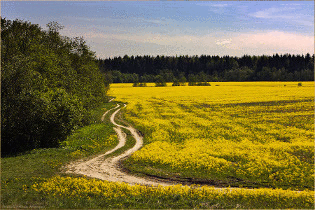Екологічно безпечні методи контролю чисельності шкідників у сучасних агротехнологіях
DOI:
https://doi.org/10.33730/2077-4893.4.2021.252957Ключові слова:
шкідливі організми, комахи-фітофаги, втрати врожаю, контроль численності шкідників, біологічний контроль, інтегрований захист рослинАнотація
Питання захисту сільськогосподарських культур від шкідників постійно зберігає свою актуальність. Унаслідок шкідливої дії членистоногих щороку втрати врожаю в світі становлять 18–20%, що оцінюється на суму понад 470 млрд дол. США. Більша частина втрат вирощеного врожаю відбувається у польових умовах до збирання врожаю і потребує низки заходів захисту рослин від шкідників. Хімічний метод захисту рослин від шкідливих організмів продовжують застосовувати більшість агровиробників, що підтверджує позитивна динаміка розвитку ринку пестицидів у світі із щорічним зростанням на 2,5–3%. Серед спектра хімічних засобів захисту рослин продаж інсектицидів становить 25,3% світових продажів. Незважаючи на використання близько 3 млн т пестицидів на рік, рівень втрат урожаю від шкідливої ентомофауни залишається значним. Водночас, погіршення фітосанітарного стану агроекосистем, що спричинено низкою абіотичних і біотичних чинників, потребує якісної оцінки стану і визначення напрямів перебудови комплексів шкідливих організмів в агробіоценозах та розроблення нових інноваційних, екологічно безпечних заходів контролю їх численності. У сучасних агротехнологіях вирощування сільськогосподарських культур дедалі ширше застосовують альтернативні екологічно безпечні методи контролю численності шкідників, що відповідає принципам інтегрованого захисту рослин і заміни хімічних інсектицидів на біологічні препарати або інші безпечні для навколишнього природного середовища методи. Про це свідчить позитивна динаміка розвитку світового ринку біопестицидів із прогнозом щорічного зростання на 14,7%, який до 2025 р. може досягнути 8,5 млрд дол. США. У лінійці біопестицидів за функціональним призначенням на світовому ринку 47% становлять препарати проти комах-фітофагів. Ефективний контроль численності шкідників у сучасних агротехнологіях базується на застосуванні біологічного контролю, мікробних пестицидів, хімічних сполук, що продукуються живими організмами і змінюють поведінку шкідників, вторинних метаболітів рослин (наприклад, феноли та поліфеноли, терпеноїди, алкалоїди), створенні стійких сортів рослин та імунізації рослин, тощо.
Посилання
Fedorenko, V.P. (Ed.) (2012). Stratehiia i taktyka zakhystu roslyn [Strategy and tactics of plant protection]. (Vol. 1). Кyiv [in Ukrainian].
Oerke, E.C. (2006). Crop losses to pests. Journal of Agricultural Science, 144, 31–43 [in English].
Sharma, S., Kooner, R., Arora, R. & Sandhu S. (Еds.). (2017). Insect Pests and Crop Losses. Breeding Insect Resistant Crops for Sustainable Agriculture. (рр. 45–66). Springer, Singapore [in English].
Borzykh, O.I. (2020). Naukove obgruntuvannia poperedzhennia fitosanitarnykh ryzykiv u transformovanykh biotsenozakh [Scientific substantiation of phytosanitary risk prevention in transformed biocenoses]. Quarantine and plant protection — Karantyn i zaxyst roslyn, 4–6, 3–7 [in Ukrainian].
Fedorenko, V.P. (2014). Perspektyvy entomolohichnykh doslidzhen v Ukraini [Prospects for entomological research in Ukraine]. Plant protection and quarantine — Zashhit i karantin rastenij, 60, 415–425 [in Ukrainian].
Mostoviak, I.I., Demyanyuk, O.S. & Boroday, V.V. (2020). Osoblyvosti formuvannia fitopatohennoho fonu mikromitsetiv — zbudnykiv khvorob v ahrotsenozakh zernovykh zlakovykh kultur Pravoberezhnoho Lisostepu Ukrainy [The formation of phytopathogenic fond in agrocenoses of cereals of the right-bank Forest-steppe of Ukraine]. Ahroekolohichnyi zhurnal — Agroecological journal, 1, 28–38. DOI: https://doi.org/10.33730/2077-4893.1.2020.201266 [in Ukrainian].
Mostoviak, I.I., Demyanyuk, O.S. & Lisovyi, M.M. (2020). Ekolohichna struktura shkidlyvoho entomokompleksu ahrotsenoziv zernovykh zlakovykh kultur Tsentralnoho Lisostepu Ukrainy [The ecological structure of the harmful entomocomplex of agrocenoses of cereal crops of the Central ForestSteppe of Ukraine]. Ahroekolohichnyi zhurnal — Agroecological journal, 2, 31–39. DOI: https://doi.org/10.33730/2077-4893.2.2020.207678 [in Ukrainian].
Kryvenko, A.I. & Shushkivska N.I. (2017). Rehuliuiucha rol pryrodnykh entomofahiv ta vplyv na nykh preparativ z riznym mekhanizmom dii v ahrotsenozakh zernovykh kolosovykh kultur u Tsentralnomu Lisostepu Ukrainy [Regulatory role of natural entomophages and the influence of drugs with different mechanism of action on them in agrocenoses of grain crops in the Central Forest-Steppe of Ukraine]. Ahrobiolohiia — Agrobiology, 1, 73–79 [in Ukrainian].
Stryhun, O.O. & Suddenko, Yu.M. (2016). Vydovyi sklad shkidlyvoi entomofauny ahrobiotsenozu pshenytsi ozymoi v Pravoberezhnomu Lisostepu Ukrainy [Species composition of harmful entomofauna of winter wheat agrobiocenosis in the Right-Bank Forest-Steppe of Ukraine]. Visnyk Poltavskoi derzhavnoi ahrarnoi akademii — Bulletin of the Poltava State Agrarian Academy, 3, 15–18 [in Ukrainian].
Glazunova, N.N., Bezgina, Yu.A. & Maznicyna, L.V. (2014). Ehffektivnost’ sovremennykh priyomov zashchity posevov ozimoj pshenicy ot vreditelej [The effectiveness of modern methods of protecting winter wheat crops from pests]. Sovremennye problemy nauki i obrazovaniya — Modern problems of science and education, 6. URL: http://www.scienceeducation.ru/ru/article/view?id=16661 [in Russian].
Balykina, E.B., Trikoz, N.N., Yagodinskaya, L.P. & Korzh, D.A. (2017). Analiz fitosanitarnogo sostoyaniya plodovykh nasazhdenij Kryma [Analysis of the phytosanitary state of the fruit plantations of the Crimea]. Plodovodstvo i vinogradarstvo Yuga Rossii — Fruit growing and viticulture of the South of Russia, 44 (02), 1–13 [in Russian].
Lamichhane, J.R., Dachbrodt-Saaydeh, S., Kudsk, P. & Messеan, A. (2016). Toward a reduced reliance on conventional pesticides in European agriculture. Plant Disease, 100, 10–24 [in English].
Deutsch, C.A., Tewksbury, J.J. & Tigchelaar, M. (2018). Increase in crop losses to insect pests in a warming climate. Science, 361, 916–919 [in English].
Lamichhane, J.R., Barzman, M. & Booij, K. (2015). Robust cropping systems to tackle pests under climate change. A review. Agronomy for Sustainable Development, 35, 443–459 [in English].
Paini, D.R., Sheppard, A.W. & Cook, D.C. (2016). Global threat to agriculture from invasive species. Proceedings of the National Academy of Sciences of the United States of America, 113, 7575–7579 [in English].
Bebber, D.P., Ramotowski, M.A. & Gurr, S.J. (2013). Crop pests and pathogens move polewards in a warming world. Nature Climate Change, 3, 985 [in English].
Green, K.K., Stenberg, J.A. & Lankinen, A. (2020). Making sense of Integrated Pest Management (IPM) in the light of evolution. Evolutionary Applications, 13 (8), 1791–1805 [in English].
Stenberg, J.A. (2017). A Conceptual Framework for Integrated Pest Management. Тrends in Plant Science, 22 (9), 759–769 [in English].
Dara, S.K. (2019). The New Integrated Pest Management Paradigm for the Modern Age. Journal of Integrated Pest Management, 10 (1), 12 [in English].
Nishimoto, R. (2019). Global trends in the crop protection industry. Journal of Pest Science, 44 (3), 141–147 [in English].
Phillips, М. (2019). Agrochemical Industry Development, Trends in R&D and the impact of regulation. Pest Management Science, 76 (10), 3348–3356 [in English].
IMARC. URL: https://www.imarcgroup.com [in English].
Agarwal, M. & Verma, A. (2020). Modern Technologies for Pest Control: A Review. Biotechnology in Mining and Metallurgical Industry. London [in English].
Zhemchuzhin, S.G., Spiridonov, Yu.Ya. & Bosak, G.S. (2019). Biopesticidy: sovremennoe sostoyanie problemy [Biopesticides: current state of the problem]. Agrokhimiya — Agrochemistry, 11, 77–85 [in Russian].
Monastyrskij, O.A. (2019). Biopreparaty: tipy, rynki v Rossii i v drugikh stranakh [Biologicals: types, markets in Russia and in other countries]. Agrokhimiya — Agrochemistry, 11, 86–90 [in Russian].
Maksimov, I.V., Veselova, S.V. & Nuzhnaya, T.V. (2015). Stimuliruyushchie rost rastenij bakterii v regulyacii ustojchivosti rastenij k stressovym faktoram [Bacteria stimulating plant growth in the regulation of plant resistance to stress factors]. Fiziologiya rastenij — Plant physiology, 62 (6), 763–775 [in Russian].
Pieterse, C.M., Zamioudis, C. & Berendsen, R.L. (2014). Induced systemic resistance by beneficial microbes. Annual Review of Phytopathology, 52, 347–375 [in English].
Zakharenko, V.A. (2019). Immunitet zernovykh kul’tur v upravlenii fitosanitarnymi riskami zernovykh agroehkosistem [Immunity of cereals in the management of pest risks in cereal agroecosystems]. Agrarnaya nauka — Agricultural science, 2, 19–24 [in Russian].
Aartsma, Y., Bianchi, F.J. & Werf, W. (2017). Herbivore-induced plant volatiles and tritrophic interactions across spatial scales. New Phytologist, 216 (4), 1054–1063 [in English].
Veselova, S.V., Burkhanova, G.F. & Rumyancev, S.D. (2019). Bakterii roda Bacillus v regulyacii ustojchivosti pshenicy k obyknovennoj zlakovoj tle Schizaphis graminum Rond [Bacteria of Bacillus in the regulation of wheat resistance to the common grass aphid Schizaphis graminum Rond.]. Prikladnaya biokhimiya i mikrobiologiya — Applied Biochemistry and Microbiology, 55 (1), 56–63 [in Russian].
Baroffio, C.A., Sigsgaard, L. & Ahrenfeldt, E.J. (2018). Combining plant volatiles and pheromones to catch two insect pests in the same trap: Examples from two berry crops. Crop Protection, 109, 1–8 [in English].
Rice, M.E., Zou, Y., Millar, J.G. & Hanks, L.M. (2020). Complex Blends of Synthetic Pheromones are Effective Multi-Species Attractants for Longhorned Beetles (Coleoptera: Cerambycidae). Journal of Economic Entomology, 113 (5), 2269–2275 [in English].
Morrison, W.R., Blaauw, B.R. & Short, B.D. Successful management of Halyomorpha halys (Hemiptera: Pentatomidae) in commercial apple orchards with an attract-and-kill strategy. Pest Management Science, 75 (1), 104–114 [in English].
Kenis, M., Auger-Rozenberg, M.A. & Roques, A. (2009). Ecological effects of invasive alien insects. Biological Invasions, 11, 21–45 [in English].
Zhang, H., Potts, S.G., Breeze, T. & Bailey, A. (2018). European farmers incentives to promote natural pest control service in arable fields. Land Use Policy, 78, 682–690 [in English].
Smagghe, G., Zotti, M. & Retnakaran, A. (2019). Targeting female reproduction in insects with biorational insecticides for pest management: A critical review with suggestions for future research. Current Opinion in Insect Science, 31, 65–69 [in English].
Panchenko, T.P., Chervyakova, L.N. & Gavrilyuk, L.L. (2016). Regulyatory rosta i razvitiya nasekomykh dlya ehkologicheski bezopasnoj zashchity plodovykh kul’tur v Lesostepi Ukrainy [Regulators of growth and development of insects for environmentally safe protection of fruit crops in the forest-steppe of Ukraine]. Zashchita rastenij: sbornik nauchnykh trudov — Plant protection: collection of scientific papers, 40, 238–244 [in Russian].
Miresmailli, S. & Isman, M.B. (2014). Botanical insecticides inspired by plant-herbivore chemical interactions. Trends in Plant Science, 19, 29–35 [in English].
Pavela, R. (2016). History, presence and perspective of using plant extracts as commercial botanical insecticides and farm products for protection against insects — a review. Plant Protection Science, 52 (4), 229–241 [in English].
Kandul, N.P., Liu, J. & Sanchez, H.M. (2019). Transforming insect population control with precision guided sterile males with demonstration in flies. Nature Communications, 10, 84 [in English].
Morhun, V.V. & Topchii, T.V. (2018). Znachennia stiikykh sortiv ozymoi pshenytsi, vyvchennia dzherel i donoriv stiikosti do shkidnykiv ta osnovnykh zbudnykiv khvorob [Importance of resistant varieties of winter wheat, study of sources and donors of resistance to pests and major pathogens]. Fiziologiya rastenij i genetika — Plant physiology and genetics, 50 (3), 218–240 [in Ukrainian].
Shapiro, I.D., Vilkova, N.A. & Slepyan, E.I. (1986). Immunitet rastenij k vreditelyam i boleznyam [Plant immunity to pests and diseases]. Moskva: Agropromizdat [in Russian].
Kremen, C. & Merenlender, A.M. (2018). Landscapes that work for biodiversity and people. Science, 362, 304–315 [in English].
Gurr, G.M., Wratten, S.D., Landis, D.A. & You, M. (2017). Habitat management to suppress pest populations: progress and prospects. Annual Review of Entomology, 62, 91–109 [in English].
Albert, L., Franck, P., Gilles, Y. & Plantegenest, M. (2017). Impact of аgroecological іnfrastructures on the dynamics of Dysaphis plantaginea (Hemiptera: Aphididae) and іts natural еnemies in Apple Orchards in Northwestern France. Environmental Entomology, 46, 528–537 [in English].
##submission.downloads##
Опубліковано
Номер
Розділ
Ліцензія
Авторське право і ліцензування
Умови ліцензії: автори зберігають авторські права і надають журналу право першої публікації з роботою, одночасно ліцензованої за ліцензією Creative Commons Attribution License International CC-BY, яка дозволяє іншим ділитися роботою з визнанням авторства роботи і початкової публікації в цьому журналі.
Якщо стаття прийнята до публікації в «Агроекологічний журнал», автор повинен підписати угоду про передачу авторських прав. Угода відправляється на поштову (оригінал) або адресу електронної пошти (відсканована копія) редакції журналу.
Цією угодою автор підтверджує, що представлені матеріали:
- не порушують авторських прав інших осіб або організацій;
- раніше не публікувались в інших видавництвах і не були представлені для публікації в інших виданнях.
Автор передає редакції «Агроекологічного журналу» права на:
- публікації статті українською (англійською) мовою і поширення її друкованої копії;
- поширення електронної копії статті, а також електронної копії перекладу статті на англійську мову (для статей українською мовою), будь-якими електронними засобами (розміщення на офіційному сайті журналу, електронних баз даних, сховищ тощо) друкована копія перекладу.
Автор залишає за собою право без згоди редакції та засновників:
- Використовувати матеріали статті повністю або частково в ознайомлювальних цілях.
- Використовувати матеріали статті повністю або частково для написання власних дисертацій.
- Використовувати матеріали статті для підготовки тез доповідей, доповідей конференцій, а також усних доповідей.
- Додати електронні копії статті (включаючи остаточну електронну копію, завантажену з офіційного сайту журналу) за адресою:
- персональні веб-ресурси всіх авторів (веб-сайти, веб-сторінки, блоги тощо);
- веб-ресурси установ, в яких працюють автори;
- некомерційні веб-ресурси відкритого доступу (наприклад, arXiv.org).
У всіх випадках наявність бібліографічного посилання на статтю або гіперпосилання на її електронну копію на офіційному сайті журналу є обов'язковим.



